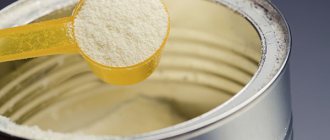Every baby after birth undergoes adaptation to extrauterine life. And one of the stages of this process is associated with the digestive system, which adapts to the new type of nutrition. Therefore, gas leaks in newborns with artificial feeding are a natural phenomenon rather than an exceptional one. You shouldn’t be afraid of it, you just need to take timely measures and study ways to help your baby if he is suffering from flatulence.
What is the difference between gas and colic?
The problem of gas and colic is considered quite common. Gases in newborns accumulate in the small intestines and are accompanied by bloating and discomfort. The baby grunts, winces, worries, trying to fart. Gas formation does not cause pain or severe suffering in the baby, so sudden crying and screaming may not be heard.
Intestinal colic, on the contrary, entails painful sensations, so the child may cry for quite a long time. Often colic is caused by gases that swell the baby's sensitive intestines. That is why you first need to deal with increased gas formation and manifestations of flatulence.
Prevention of flatulence
The first year of life for a baby is the most difficult and most important.
In addition to the fact that he masters new skills, parents begin to introduce complementary foods.
And this can be one of the main reasons for the formation of intestinal colic and bloating in children older than 6 months.
To protect your child from unpleasant painful sensations, you should approach innovations in his diet with special care and caution.
For the first complementary foods, you need to choose sorbent products that contain a lot of dietary fiber. These are pear, apple, carrots, buckwheat porridge. To maintain the acid balance, you can gradually introduce children's fermented milk products.
Fermented milk and dairy products contain natural probiotics. In large quantities they can cause increased gas formation.
With the introduction of new food products, not only flatulence may occur, but also other difficulties in the functioning of the intestines.
To prevent them, you can give your child medications containing prebiotics and probiotics:
- Simbiter;
- Linux;
- Bifidumbacterin;
- Acidolac;
- Bifiform.
Do not forget about walks and games in the fresh air, which can strengthen the child’s immune system, which will allow him to endure flatulence easier and faster.
Almost all children suffer from intestinal colic and bloating at an early age. The main task of parents is to prevent their occurrence, and if they occur, to alleviate their course. Simple actions and light massages, coupled with modern medications, will allow you to forget about restless nights for a long time, and will give a good mood to the child and parents.
Such a phenomenon as increased gas formation in an infant is not a disease, but flatulence and gases cause severe discomfort to the child. Read how to deal with this on our website.
You will find even more information about the causes of bloating in children under one year of age in this material.
Causes of gas in an infant
As in an adult, gas formation in an infant is a natural process that accompanies the act of digesting food. If a lot of gases are formed, they do not have time to be eliminated and accumulate in the intestines, disrupting the normal functioning of the digestive system.
Important: gases can appear constantly due to improper feeding of the baby, in which he will swallow air - a technique for attaching a newborn to the breast.
Why do gases form in a newborn during breastfeeding or bottle feeding?
- The digestive system is immature, still developing. The child’s intestines are populated by microflora, active carbohydrate metabolism begins, and as a result, gases appear.
- An allergic reaction to foods consumed by a nursing mother or to formula during artificial feeding. It is known that the inclusion of whole cow's milk, cabbage, legumes, carbonated drinks, and chocolate in a woman's diet causes colic in infants - which foods are prohibited for a nursing mother.
- Overfeeding is a problem for artificial babies. It does not pose a risk to breastfed children. The baby will suck exactly as much milk as he needs.
- Lactase deficiency, in which lactase, an enzyme that helps digest milk, is not produced.
- New products can cause gas in a baby. A lot of foods containing sugar (for example, juices) can cause colic and loose stools.
- Microflora disturbances occur in bottle-fed babies more often than in breast-fed babies. The baby sucks less greedily, swallows less air, and receives probiotics from mother's milk. Probiotics are necessary for humans to quickly digest food and absorb nutrients.
- Improperly organized feeding is a common mistake of young parents. Due to frequent feeding, food does not have time to be digested, and gas is formed. A schedule and maintaining a two-hour interval between meals will help you avoid this problem.
Other reasons that cause gas in infants include tight swaddling, tight elastic on the diaper, and overheating.
Less common factors include:
- prematurity;
- emotional instability in the family;
- smoking of a nursing mother;
- incorrectly selected mixture;
- weak abdominal muscles.
Causes of gas during formula feeding
In addition to the natural causes of gas formation in babies, the following factors cause increased pain:
- Pathology of the gastrointestinal tract.
- Insufficient amount of necessary enzymes.
- Disturbed microflora of the large intestine.
- Helminthic infestations.
- Violation of proper diet.
- Weakened peristalsis.
- Violation of technology for preparing formula for artificial feeding.
- The baby accidentally swallowed air while feeding or crying.
- Short breaks between meals.
- Lactose deficiency.
Attention! Children who have a restless character are more likely than others to suffer from flatulence, due to the fact that their intestinal muscles are constantly tense.
Signs of Gas in Babies
It is difficult for inexperienced parents to understand what is bothering their child. To get rid of the problem, you need to know its main symptoms. How does a newborn behave when exposed to gas? The child has:
- Belching is a natural way to remove gases accumulated in the stomach. After feeding, every effort must be made to ensure that the baby is able to burp. If hiccups (read more about hiccups) and burping occur more frequently, this may indicate that a lot of air is being swallowed during feeding.
- Regurgitation is accompanied by regurgitation. But sometimes it occurs due to an inappropriate formula, prohibited foods that the nursing mother has eaten, or due to the feeding process being too fast - other causes of regurgitation.
- Accumulated gases in the intestinal area interfere with the movement of gastric juice, forcing it to stop. Bloating is the first symptom of gas entering the intestines and accumulating on the intestinal walls. Pressure is created, the child feels sharp painful spasms and discomfort. When palpated, a hard, stone tummy is observed.
- It is normal for newborns to fart 15-20 times a day. But increased flatulence indicates incomplete digestion of food.
- Crying is a child's main way to communicate his problems. It can occur when the baby is hungry, something hurts, he is tired, he is tormented by colic - the eternal companions of gas formation. With intestinal gas, the child only tenses, clenches his fists and groans. How to understand why a newborn is crying
- Any discomfort disturbs the baby's peace and sleep. It has been noticed that children begin to worry suddenly, usually after eating or during sleep.
In almost all infants, gas symptoms can be reduced to three principles:
- The appearance of discomfort after the first three weeks of life.
- The duration of pain attacks per day can be added up to three hours.
- By the fourth month the problem goes away without a trace. If this does not happen, you need to consult an experienced specialist.
How to cope
Mom can help cope with this situation. To do this, when breastfeeding, she needs to exclude legumes, black bread and cabbage from her menu. It is worth considering that some babies suffer from lactose intolerance. In such situations, the mother needs to exclude all dairy products from her diet. In the first months after childbirth, mothers should not eat raw fruits and vegetables, as fiber can cause a lot of gases to form in the baby’s intestines. You can replace raw fruits with baked apples and pears. When preparing them, you should not use conventional recipes that call for adding a lot of sugar to the dish. It is better to completely give up sugar until the child’s digestion improves.
How to help a child with gas in the stomach
Gas formation in infants is an inevitable process. Therefore, you should know how to help a newborn. There are several proven methods to alleviate the child's condition.
Laying on the tummy and wearing in a column
Lying on his stomach, the child trains muscle tissue, learns to hold and raise his head, and studies the world around him from a different angle. You need to accustom your baby to this beneficial position gradually, starting with one or two minutes. It is better to do this before feeding, otherwise the baby may burp profusely immediately after eating. The room must be at a normal temperature so that the baby does not freeze or become hypothermic.
Carrying it in a column and pressing it to the stomach of an adult is considered an excellent prevention of gas. It is recommended to carry the child vertically until the excess air escapes - correct wearing in a column. At the same time, they talk to the baby, sing songs, and stroke the back. If the air does not leave for a long time, you need to move back and forth or to the sides. This massage will speed up the liberation process.
Warm
If you fill a heating pad with warm water and apply it to the newborn’s tummy, the spasms will go away, the pain will subside, and the gasps will be able to calmly go away. If you don’t have a heating pad at home, you can replace it with a warm diaper. Before placing the diaper on the tummy, iron it on both sides. A warm bath helps relieve spasms. The main thing is that the child likes water procedures.
Massage
This is one of the simple non-invasive relaxation techniques in the fight against gas. Massage is carried out half an hour after feeding or at the first signs of discomfort:
- The child is placed on his back and the legs begin to rotate, as if he were riding a bicycle. You can bend your legs, bent at the knees, towards your tummy until the gasps go away.
- Using light massage movements, rub the baby's tummy clockwise with the palm of your hand. Such touches have a calming effect and help remove gases along the intestines.
- The child is placed face down on the adult's lap. Gently move your legs to massage your tummy a little. Such movements will help the bubbles move forward. In this case, it is advisable to stroke the baby on the back.
Breast massage should not cause pain. Correct, competent movements will relieve a newborn from suffering in a short time.
- How to massage an infant with intestinal colic
Medicines
If massage does not help, the baby often suffers from gas, doctors advise using medications. There are 4 types of medications that relieve a child from gas.
They all work differently:
- Simethicone is a carminative and antifoaming active ingredient aimed at binding and eliminating bubbles in the intestines. The released gas is quickly absorbed or eliminated naturally from the body without creating any unpleasant sensations. Often, simethicone-based drops include synthetic substances, dyes and flavors.
- Homeopathic medicines are based on natural substances that ensure safety for newborns and effectively eliminate gas. One such remedy is dill water, based on fennel or dill seeds. The product is sold at the pharmacy, but you can prepare it yourself. 10-15 fennel seeds pour a glass of boiling water on the floor and let it brew. Afterwards, the medicine is poured into the baby’s bottle and given to him to drink. If the child is on breastfeeding, then the mother drinks the infusion herself and then feeds the child.
- Probiotics significantly alleviate the baby’s condition if used for several weeks in a row. When a baby is introduced to complementary foods, it is recommended to give him probiotics to fill the intestines with beneficial bacteria.
- Enzymes - make up for the lack of active components involved in food digestion. If lactase deficiency is noted, medications containing the lactase enzyme are prescribed. The danger of using such drugs lies in the duration of the course of therapy. The baby's pancreas should produce such substances itself, and not receive them from the outside.
The reason is dysbiosis
Gases can be caused by dysbacteriosis. It usually develops if you use an unwashed pacifier, dirty toys, and also after taking antibiotics by the child and his mother. This pathology can be recognized by the presence of mucous inclusions and foam in the stool.
The treatment method for dysbacteriosis should be selected exclusively by a doctor after confirming the diagnosis. It usually involves removing toxic elements and restoring digestive function.
If your baby suffers from increased gas formation, accompanied by an unpleasant odor, you should not immediately go to see a doctor or install a tube to remove gases. Typically, this condition is not a pathology and can be eliminated using gentle methods, for example, thermal or massage procedures.
Quick help for your baby with gas formation
Inexperienced parents ask doctors what to do during prolonged, aggravated attacks? In such cases, pain is relieved by emergency means: an enema or a gas outlet.
How to remove gas with an enema?
- first you need to purchase a small rubber bulb with a soft tip;
- the product must be boiled for 15-20 minutes;
- For manipulation you will need boiled water at room temperature. Cold water can cause spasms, and warm water can provoke the absorption of toxins accumulated in the intestines;
- air is squeezed out of the pear and water is filled into it;
- the tip is lubricated with Vaseline;
- the child is laid on his left side, his legs are pressed against his tummy in order to provide access to the anus, which is lubricated with Vaseline;
- the contents of the enema must be administered slowly, the tip should not go deeper than 2-3 cm;
- the buttocks should be kept closed so that the liquid does not spill out;
- you need to prepare the place in advance (cover it with oilcloth and a diaper) where defecation will occur.
The enema should be administered when the child is calm and relaxed. It is often impossible to use this method to release gas, as the natural defecation reflex may be suppressed.
How to give an enema to a baby without damaging his intestines
How to use the gas outlet
- The tube must be boiled. Lubricate with Vaseline;
- insert to a depth of no more than 5 cm;
- The gas outlet must be inserted using screwing movements. Gas outlets have a special limiter, which makes them safe for use by infants;
- hold on until the gassers move away;
- wash the tube after the procedure.
We also have a detailed article on our website about the gas outlet tube (from it you will learn how to choose and use it).
After the manipulation, you need to look at the baby’s behavior - whether the procedure helped him or not. This method should not be used too often, since in addition to inhibiting the natural reflex of removing gases, there is a risk of injury to the delicate mucous membrane of the rectum.
Doctor Komarovsky about flatulence in infants
According to Komarovsky, the main cause of bloating and colic in newborns is overeating.
Therefore it is recommended:
- Do not take long breaks between feedings. The baby should be applied to the breast every 2-3 hours. Otherwise, the child will get hungry and eat too much;
- Feeding should last no more than a quarter of an hour;
- Use age-specific formulas;
- Follow the instructions for diluting the mixture, do not make it too thick;
- In case of increased flatulence, use a special tube to remove gases. A tube is inserted into the anus to a depth of 3-4 cm, the tip of which is lubricated with Vaseline. To facilitate the removal of gases, you can make light rotational movements with the tube. This method should not be used often, as it leads to irritation of the rectal mucosa.
When to see a doctor
If your child has:
- fever;
- belly inflated like a drum;
- stool containing flakes, mucus, or blood;
- change in stool color - it has become green or light green;
- vomiting, frequent regurgitation;
- diarrhea;
- cyanosis, pale skin;
- sunken eyes;
- refusal to breastfeed;
- drowsiness;
- moodiness when touching the stomach;
- monotonous, altered crying.
The listed symptoms may indicate: volvulus, intestinal infection, meningitis, nervous disorders, etc. Therefore, at the first alarming signs you need to call a doctor
Causes, symptoms of increased gas formation
Gases, accompanied by an unpleasant odor, appear as a result of the digestive process. With increased gas formation, digestive function is disrupted, which leads to colic. Typically, the following symptoms may indicate increased gas formation:
- the baby's behavior has become restless;
- the child’s anxiety is not caused by ordinary discomfort: the diapers are dry, he is fed;
- the baby may often press his legs towards the abdomen;
- the baby may begin to scream for no reason within one to three hours;
- Usually the baby begins to behave restlessly closer to the evening, as well as after eating;
- Gas trains rarely depart;
- the tummy becomes hard.
If gases smell unpleasant while breastfeeding, the reasons for this may be constipation, diarrhea, and frequent regurgitation.
Why do such pathological conditions occur in infancy? Usually their appearance is due to:
- non-compliance with the dietary menu by the mother. Rational mother's nutrition plays an important role in children's digestion. Increased gas formation is promoted by the mother's consumption of dairy products, cabbage, and legumes. When they are cancelled, gases accompanied by an unpleasant odor will probably go away quickly;
- Drinking too much milk can also contribute to the formation of gases;
- Incorrect attachment to the breast during feeding or prolonged crying leads to the baby swallowing air, which can cause increased gas formation.
How to prevent gas
It is impossible to completely protect yourself from gas emissions, but simple recommendations will help reduce their duration and intensity:
- Prolonged, heart-breaking crying should not be allowed. Most newborns swallow air this way;
- It is necessary to position the baby correctly when feeding, supporting his head above his tummy. This will help him swallow milk or formula without air;
- After each feeding, the baby should burp. If the child is prone to gas formation, feeding is interrupted so that he burps freely and then starts eating with renewed vigor;
- if the newborn is not on breastfeeding, the feeding method needs to be analyzed. It is recommended to hold the bottle so that the nipple is always filled with milk; if this does not happen, the child receives a lot of air with food.
Carrying in your arms, massaging and placing on your tummy are considered the most effective ways to combat gas.
You can also read:
- Intestinal colic in infants
- Why can a newborn have a tummy ache?
"Wrong" nipple
| Formula-fed children are especially susceptible to flatulence. |
Choosing the right bottle and pacifier will also help you relieve your baby of colic and gas. The nipple with the smallest hole is considered the most suitable for newborns. Of course, the child may become disappointed with the speed at which food comes from such a bottle and begin to be capricious. It is extremely important not to “be led” by a newborn by purchasing a nipple with a larger hole and a correspondingly higher flow rate of milk.











